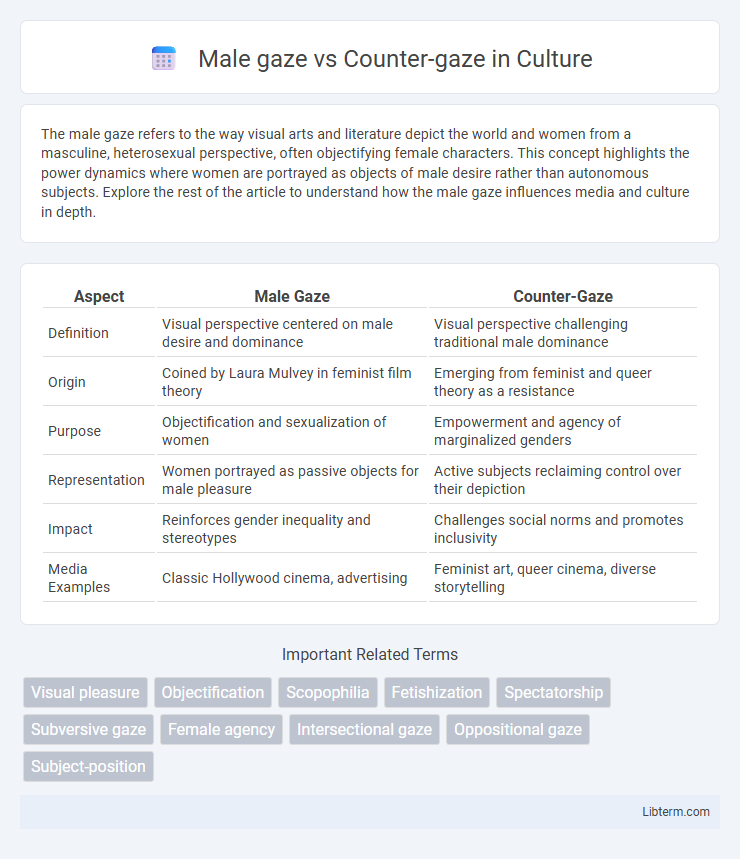The male gaze refers to the way visual arts and literature depict the world and women from a masculine, heterosexual perspective, often objectifying female characters. This concept highlights the power dynamics where women are portrayed as objects of male desire rather than autonomous subjects. Explore the rest of the article to understand how the male gaze influences media and culture in depth.
Table of Comparison
| Aspect | Male Gaze | Counter-Gaze |
|---|---|---|
| Definition | Visual perspective centered on male desire and dominance | Visual perspective challenging traditional male dominance |
| Origin | Coined by Laura Mulvey in feminist film theory | Emerging from feminist and queer theory as a resistance |
| Purpose | Objectification and sexualization of women | Empowerment and agency of marginalized genders |
| Representation | Women portrayed as passive objects for male pleasure | Active subjects reclaiming control over their depiction |
| Impact | Reinforces gender inequality and stereotypes | Challenges social norms and promotes inclusivity |
| Media Examples | Classic Hollywood cinema, advertising | Feminist art, queer cinema, diverse storytelling |
Understanding the Male Gaze: Origins and Impact
The male gaze originates from feminist film theory, identifying how visual arts often depict women from a heterosexual male perspective, reinforcing gender power imbalances. This gaze shapes societal norms by objectifying women and influencing media representation, perpetuating stereotypes and limiting female agency. Understanding the male gaze highlights the need for counter-gaze practices, which challenge dominant narratives by empowering diverse perspectives and promoting gender equity in visual culture.
Defining Counter-Gaze: A Critical Response
Counter-gaze emerges as a critical response to the male gaze by challenging dominant visual narratives that objectify women and reinforce patriarchal power structures. This concept empowers marginalized subjects, particularly women and LGBTQ+ individuals, to reclaim agency through self-representation and alternative perspectives in media and art. By subverting traditional voyeuristic spectatorship, counter-gaze promotes a more inclusive and equitable visual culture that resists oppressive gender dynamics.
Historical Context: Evolution of Visual Power Dynamics
The male gaze, rooted in early 20th-century cinema and art, reflects patriarchal visual power dynamics that position women as passive objects for male pleasure and control. Counter-gaze emerged as a feminist response in the late 20th century, challenging and disrupting these entrenched norms by reclaiming visual agency and promoting diverse, empowered female perspectives. This evolution highlights the shifting power structures in representation, revealing broader cultural struggles over identity, autonomy, and visibility.
The Male Gaze in Cinema and Media
The Male Gaze in cinema and media refers to the way visual arts are structured around a masculine viewer, often portraying women as objects of male pleasure and reinforcing gender power imbalances. This concept, introduced by Laura Mulvey in 1975, highlights how camera angles, narrative perspectives, and framing techniques are designed to satisfy heterosexual male spectatorship. Films frequently position female characters as passive subjects, reducing their roles to visual spectacles rather than active agents in the storyline.
Counter-Gaze in Contemporary Visual Culture
Counter-gaze in contemporary visual culture actively challenges the traditional male gaze by empowering marginalized subjects to reclaim agency and visibility. It fosters diverse representations that subvert objectification, highlighting perspectives of women, LGBTQ+ individuals, and other historically overlooked groups. This shift promotes critical engagement with power dynamics in media, encouraging audiences to question normative visual hierarchies and embrace multiplicity in storytelling.
Gender, Power, and Representation
The male gaze, rooted in patriarchal power structures, objectifies women by shaping media representations from a male perspective, reinforcing gender hierarchies and limiting female agency. Counter-gaze challenges this dynamic by re-centering female subjectivity, empowering women to reclaim their image and disrupt traditional power relations in visual culture. These conflicting gazes reveal the ongoing negotiation of gendered power and representation within society and media.
Intersectionality: Race, Sexuality, and the Gaze
The male gaze often reinforces dominant power structures by framing subjects through a heterosexual male perspective, marginalizing experiences of race and sexuality. Counter-gaze challenges these norms by centering marginalized identities, reclaiming agency, and offering alternative visual narratives that disrupt traditional objectification. Intersectionality highlights how race and sexuality complicate the dynamics of gaze, revealing layered oppressions and empowering diverse representations in media and art.
Subverting the Spectator: Tools of Counter-Gaze
The counter-gaze subverts the traditional male gaze by empowering marginalized subjects to reclaim agency through visual resistance and alternative representations. Techniques such as active, confrontational visuals, narrative disruptions, and participatory spectatorship enable the audience to critically engage and challenge dominant power structures. These tools transform passive consumption into dynamic interaction, fostering a more inclusive and equitable cinematic experience.
Case Studies: Films and Artworks Challenging the Male Gaze
Films like "Thelma & Louise" and artworks such as Mickalene Thomas's portraits challenge the male gaze by subverting traditional representations of women, emphasizing agency and diverse perspectives. These case studies reveal how counter-gaze strategies disrupt objectification through empowered female subjectivity and narrative complexity. Such works contribute to feminist discourse by redefining visual dynamics and promoting gender equity in media representation.
The Future of Gaze Theory in Media and Art
The future of gaze theory in media and art is increasingly centered on the counter-gaze as a transformative tool challenging the traditional male gaze, promoting diverse representations and empowering marginalized identities. Advancements in digital media and interactive technologies foster new modes of viewer engagement, enabling subjects to reclaim agency and subvert dominant visual narratives. Integrating intersectional perspectives, gaze theory continues to evolve, driving critical dialogues about power, spectatorship, and identity construction in contemporary visual culture.
Male gaze Infographic

 libterm.com
libterm.com